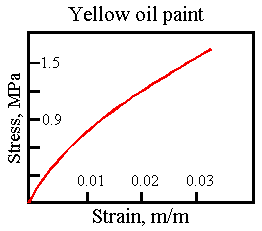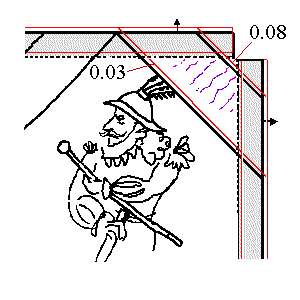
 |
Stress, strain and Craquelure - 2 |
The simplest use for a stress-strain diagram is to predict, or explain, the failure of a material when it is strained.
 Here is the diagram for a yellow oil paint measured by Marion Mecklenburg (1), which I have simplified.
Here is the diagram for a yellow oil paint measured by Marion Mecklenburg (1), which I have simplified.
Notice that the breaking strain is about 0.03 (3%). Don't bother about the breaking stress just now, because it doesn't come into this discussion.
An oil painting on canvas is stretched on a wooden frame whose purpose, apart from presenting the canvas flat to the painter and later to the onlooker, is to prevent movement of the canvas, and the superimposed paint, under the influence of temperature, humidity, and handling.
It was, however, common for finished canvas paintings to be removed from the artist's studio rolled up ready for remounting on a wooden frame in the customer's house or temple.
 This was a relatively harmless process, because the paint was young and flexible, in other words it had a high breaking strain. In time, however, the canvas becomes slack, for reasons that will be described later. The conservator will then stretch the painting to restore its original crisp appearance. Let us see what happens (in the worst case of course, otherwise it wouldn't be interesting).
This was a relatively harmless process, because the paint was young and flexible, in other words it had a high breaking strain. In time, however, the canvas becomes slack, for reasons that will be described later. The conservator will then stretch the painting to restore its original crisp appearance. Let us see what happens (in the worst case of course, otherwise it wouldn't be interesting).
A canvas painting is mounted on four wooden beams, which we assume are very stiff compared to the canvas and the paint. The tension on the painting is increased by forcing open the corner joints with wedges. The diagram shows the expanded stretcher beams in red.
The overdressed warrior is emerging from his tent, indicated by the diagonal lines. These lines were painted right to the edge of the canvas. It is therefore easy to mark their position after stretching (thinner lines, in red), because the ends of the lines must move with the edge of the wooden beams.
The line nearest the corner has stretched by 0.08 m/m. The paint layer has cracked, as shown by the short purple lines, and as predicted from the stress-strain curve. The diagonal line nearest the duke's head has only stretched 0.03 m/m, so the paint here is just intact but highly stressed at about 1.5 MPa.
Notice that the extension of the two diagonal lines is equal but the extension, as a fraction of the original length, is greater in the line nearest the corner.
The cracking occurs at right angles to the diagonal direction of the stress, and is often seen on real paintings. A detailed analysis would reveal that the paint in the centre of the picture is the least stressed.
This is an example of the direct use of the stress-strain diagram. It is, however, much more usual for the stress to develop inside the material of the painting, as a result of climatic change, with no significant strain imposed from outside.
1. Art in Transit, Edited by Marion Mecklenburg, Washington 1991, ISBN 0-89468-163-X p199
On to the next chapter

This work is licensed under a Creative Commons Attribution-Noncommercial-No Derivative Works 3.0 License.